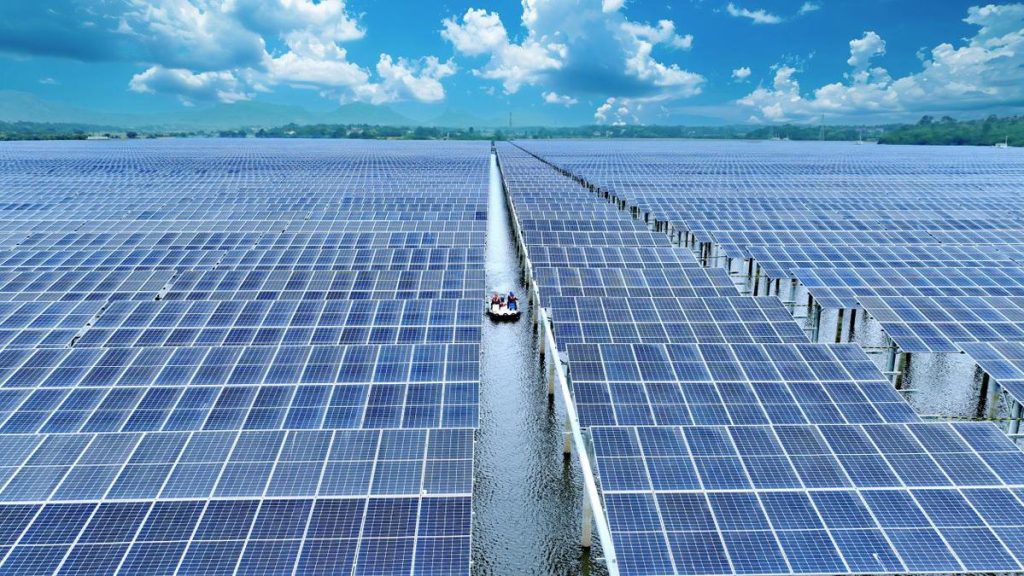On Sept 26, in Yanghe village, Qilin town, Zongyang county, Anhui province, rows of photovoltaic panels were neatly arranged at the Zuzhuang Reservoir, reflecting a golden glow as they caught the sun’s rays. A small boat rowed across the serene lake, stirring up ripples. The Wanmei Communist Party member service team from the State Grid Tongling Power Supply Company was assisting Huadian Fuxin Zongyang New Energy Co Ltd in conducting a power consumption inspection at the Fuqiao Photovoltaic Power Station.

Workers from State Grid Tongling Power Supply Company assist Fuqiao Photovoltaic Power Station in conducting inspections of power lines and equipment. [Photo provided to chinadaily.com.cn]
In December 2021, the Fuqiao Photovoltaic Power Station commenced the construction of a “Fishery-Photovoltaic Integration” power station in Qilin and Qianqiao townships, Zongyang county, Anhui province. Currently, the total installed capacity stands at 108.213 MW, with 31 power generation units spread across 11 lakes and reservoirs in these two townships, generating an average annual output of about 114.1647 million kWh.
Since the inception of this photovoltaic project, the State Grid Tongling Power Supply Company has proactively launched the “Wanmei · 360” service initiative, actively facilitating the grid connection of the power station, conducting regular visits, assisting with power consumption inspections and maintenance, and fully ensuring the delivery of green power to thousands of households.
Zongyang county, situated on the northern bank of the lower reaches of the Yangtze River, boasts four prominent water systems: Caizi Lake, Baidang Lake, Chenyao Lake, and Liangsa Lake. The combined water surface area spans 344.39 square kilometers, constituting one-third of the county’s total land area. This location offers unique advantages in implementing “integrated fishery and photovoltaic” power generation.
Since the inaugural “integrated fishery and photovoltaic” power station was established in Zongyang county in 2021, numerous such stations of varying sizes have sprung up, with the county’s total installed capacity of “integrated fishery and photovoltaic” power generation reaching 500,000 kW, accounting for 91.63 percent of the total installed capacity of photovoltaic power generation.
Currently, the total installed capacity of various new energy power generation systems connected to the grid in Zongyang county stands at 571,400 kW, comprising 545,700 kW of photovoltaic power generation, 16,700 kW of wind power generation, and 9,000 kW of biomass power generation.
The integration of a high proportion of large-scale new energy sources into the power grid has raised higher demands on grid operation. In recent years, the State Grid Tongling Power Supply Company has expedited the upgrading of the grid structure, reinforced the construction of supporting facilities for new energy grid connection, and made every effort to ensure the consumption of clean electric energy.
Since 2016, the State Grid Tongling Zongyang Power Supply Company has been committed to the integrated management of planning, construction, and operation and maintenance. The 220kV Dujiang Substation, 110kV Pucheng Substation, Baihu Substation, and Shuangxi Substation have been successively completed and put into operation. The expansion of the 110kV Qianwang Substation and Shilin Substation has been completed, and the renovation of eight 35kV substations has been carried out. Currently, Zongyang county boasts transmission lines ranging from 35 to 110 kV, totaling 439.75 kilometers, and 10 kV distribution lines spanning 2,496.72 kilometers, providing strong support for the integration and grid connection of new energy sources.
In addition to the numerous “integrated fish and photovoltaic” power stations in Zongyang county, an increasing number of enterprises and rural residents are now opting to fully utilize the roofs of factories and residential buildings to install photovoltaic panels. This allows them to generate and consume their own photovoltaic power, with any surplus being fed back into the grid. “During peak periods, our factory’s rooftop photovoltaics can produce 800,000 kilowatt-hours of electricity per month, saving businesses 160,000 yuan in costs,” said Dai Qinghong, the head of Tongling Wanhua Hexiang Board Co Ltd.
To better facilitate the grid connection of distributed photovoltaic users, the State Grid Tongling Power Supply Company actively implements the State Grid Corporation’s working system for integrating new energy projects into the power grid. It establishes a dedicated team of Party members to provide comprehensive services for photovoltaic power stations, including preliminary planning and grid connection, operation and maintenance, policy consultation, and subsidy distribution. This ensures that all qualified green electricity is fully integrated into the grid.
According to data, from January to August this year, the cumulative on-grid electricity generated from various new energy sources in Zongyang county, Anhui province, reached 484.083 million kWh, accounting for 39.67 percent of the county’s total electricity consumption. Currently, China’s renewable energy power generation accounts for one-third of the total electricity consumption in society, steadily advancing toward the goals of “carbon peaking and carbon neutrality”.

